Introduction: The Significance of Inflation Theories
Hello everyone! Inflation, the sustained increase in the general price level of goods and services, is a crucial economic phenomenon. Over the years, economists have developed various theories to explain and predict inflation. Two prominent theories are the classical theory and the Keynesian theory. Today, we’ll explore the differences between these theories and how they shape our understanding of inflation.

The Classical Theory: Market Forces and Self-Regulation
The classical theory, rooted in the works of economists like Adam Smith and David Ricardo, emphasizes the role of market forces in determining inflation. According to this theory, inflation is primarily a result of changes in the money supply. When the money supply increases, individuals and businesses have more money to spend, leading to a rise in demand. As demand outpaces supply, prices increase, causing inflation. The classical theory also posits that markets are self-regulating. In other words, any imbalances caused by inflation, such as a decrease in purchasing power, will be corrected by market mechanisms over time.
The Keynesian Theory: Demand-Side Factors and Government Intervention
In contrast, the Keynesian theory, developed by economist John Maynard Keynes, places greater emphasis on demand-side factors and the role of government in managing inflation. According to Keynes, inflation can occur due to various factors, such as excessive aggregate demand. In such cases, the government can intervene by implementing fiscal and monetary policies. For example, during periods of high inflation, the government can reduce spending or increase interest rates to curb demand. The Keynesian theory also highlights the importance of expectations and psychology in shaping inflation. If individuals and businesses anticipate future price increases, they may adjust their behavior, leading to a self-fulfilling prophecy of inflation.
Implications and Criticisms: A Balancing Act
Both the classical and Keynesian theories have had significant implications for economic policy. The classical theory, with its emphasis on market forces, has often been associated with a more hands-off approach, favoring minimal government intervention. On the other hand, the Keynesian theory has influenced policies that prioritize government intervention to stabilize the economy. However, both theories have faced criticisms. Critics of the classical theory argue that it may not adequately account for factors like market imperfections and external shocks. Meanwhile, the Keynesian theory has been criticized for potential unintended consequences of government intervention, such as inflationary expectations. Over time, economists have sought to refine these theories, often integrating elements from both perspectives.

